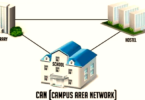7 Types of Networks and Their Use Cases
Computer networks provide the infrastructure for seamless data exchange. Their sizes and shapes differ greatly, each serving to support particular uses.
Personal Area Networks (PAN) are the smallest and most basic type of network, connecting devices like computers and mobile phones in an individual’s immediate surroundings.
1. Local Area Network (LAN)
A local area network (LAN) connects devices within a small geographical area. Commonly seen in homes for home office use, but also often found in offices and other professional settings.
LANs may be connected either through wired or wireless connections, with wireless being the more popular choice due to the use of radio signals to transmit data. Wi-Fi networks allow users to move freely within buildings without being restricted by plugging devices into outlets or worrying about signal loss.
A LAN provides more than Internet access; it can also be used for file sharing, multimedia streaming, multiplayer gaming and controlling smart home devices. A LAN’s flexible nature makes it adaptable enough to suit changing work environments by enabling managers to easily add machines or assign employees to new teams as required.

7 Types of Networks and Their Use Cases
There are two primary forms of local area networks (LANs): peer-to-peer and client-server. Peer-to-peer LANs allow multiple devices to communicate directly, while client-server LANs utilize potent computers called servers that manage application access, device access and network traffic management – although client-server LANs tend to provide greater security but may perform less well under heavy workloads. Furthermore, there are various logical and physical network topologies, such as star, ring mesh and bus topologies, among many others.
2. Personal Area Network (PAN)
Personal area networks (PANs) connect devices within an individual’s immediate environment using wireless technologies like Bluetooth, infrared, ZigBee or wireless USB. Common devices connected to PANs include laptops, smartphones, tablets and wearable devices such as smartwatches – not to mention printers, scanners and video game consoles! PANs may even be used to connect medical devices like heart monitors to doctors’ computers for remote diagnosis.
An important advantage of a personal area network (PAN) is its user-friendliness and maintenance ease; there’s no complicated wiring or server setup process necessary, and adapting its structure for different environments is simple.

PAN networks can also be cost-efficient due to standardized protocols allowing devices to connect without advanced configuration, making the network more stable and reliable than larger networks that rely on servers and operate within a short range. Furthermore, being powered by wireless technologies like Bluetooth makes them portable enough to follow users or equipment around in situations such as conference rooms or surgeries where networks must move with them.
3. Wireless Local Area Network (WLAN)
WLANs use radio waves to connect devices within an area and are an integral component of home, office and public connectivity. Sometimes called “Wi-Fi,” WLANs play an integral role in providing home, office and public connectivity solutions.
WLANs can be constructed either in ad hoc or infrastructure mode. An infrastructure WLAN includes a wireless router (base station) that connects wireless devices such as computers and mobile phones; users are then free to move about freely within its coverage area, such as within a room in their home or an office, without losing connection with it.
Ad-hoc WLANs don’t rely on a central base station; rather, wireless devices connect directly with each other without using any base stations as intermediaries. This type of network offers greater flexibility than infrastructure WLANs.
No matter if you’re working in an office, visiting friends, or going hiking – internet connectivity is crucial. While it might seem mundane now, you’d certainly notice a difference if your connectivity was ever interrupted!
Thankfully, it’s possible to improve your wireless connection with just a few changes. First of all, be sure that only authorized individuals have access to your WLAN; this ensures bandwidth doesn’t get spread too thinly across users and helps maintain fast connections. Adding a mesh network could also expand its range and performance significantly.
4. Wide Area Network (WAN)
A wide-area network (WAN) enables a company with offices in Paris and New York, for instance, to transfer data between locations. As companies expand geographically, they require a robust WAN solution – otherwise, costly hardware would need to be installed at each site to ensure connectivity between all locations, making security management and performance difficult as their networks grow.
Traditional wide area network (WAN) solutions rely on either leased lines or broadband Internet connections between sites, which may lead to unequal performance between download speeds and upload speeds, incurring costly data caps as well as being slow in responding to changing traffic conditions, leading to unpredictable latency and unstable application performance.
MPLS and carrier Ethernet WAN solutions connect multiple sites over dedicated fiber links, typically used for business-critical applications like unified communications and remote access. While VPN uses static routing protocols to determine which packet takes which path, an MPLS WAN uses dynamic routing techniques that adapt network resources based on current traffic conditions and optimize resources according to policy, firewall and traffic shaping controls.
5. Virtual Private Network (VPN)
VPN stands for virtual private network and provides an encrypted link between any device connecting and a remote server, thus protecting transmitted data from anyone trying to eavesdrop. VPNs are commonly used when accessing public Wi-Fi networks for their personal security benefits.
Businesses use remote-access VPNs to allow their employees to work from home or other offsite locations without jeopardizing network security – keeping workers productive and efficient even when away from the office. This helps businesses maintain efficient operations across their organization.
Another key use case for secure remote access to intranets is providing remote employees, freelancers and business travellers with secure remote access so that they can connect to company systems just as effortlessly from remote locations as someone sitting at an office desk would.
VPNs can also help to improve internet privacy and avoid price discrimination online services that impose different prices depending on who and where you are located – masking your location using a VPN makes it harder for websites or services to target ads at you; in addition, VPNs help eliminate price discrimination when shopping for flights or travel by giving yourself an IP address from a country with more affordable prices.
6. Campus Area Network (CAN)
Campus Area Networks (CANs) are large networks designed to connect various departments within an institution such as universities, schools or organizations. A CAN combines multiple Local Area Networks (LAN) through routers, switches, hubs and large bandwidth optical fibre – also referred to as backbone trunk. A campus area network typically contains multiple VLANs (Visiblity Layer Networks) which facilitate fast data transfer rates.
Contrasting with WANs or MANs, CANs can cover large areas like college campuses or business parks while still remaining smaller than WANs.
CAN is used primarily to improve digital connectivity for users within a particular geographical location, making it particularly effective in environments with high-demand networking requirements, such as autonomous vehicle testing on university campuses or real-time monitoring of production parameters at industrial complexes.
CAN also provides an ideal method of collaboration across buildings from a central location, eliminating the need for costly Internet connectivity. Since files and data don’t need to leave the CAN in order to reach another department, transmission takes much less latency time compared with using other networks like WAN/MANs or even wired connections. Furthermore, its centralization simplifies IT maintenance while making the application of security policies simpler.
7. Wireless Local Area Network (WLAN)
WLANs use radio waves to provide connectivity for devices in a specific coverage area. WLANs connect devices directly to the internet and exchange data within locations such as homes, offices, schools and even small buildings.
WLANs may be configured in infrastructure mode or ad-hoc mode. An infrastructure mode WLAN utilizes a base station as its central component and connects endpoints such as computers, mobile phones, printers and others through endpoint bridges such as wireless access points to each endpoint; its signal strength depends on proximity between device and wireless access point and security measures like filtering of MAC addresses, encryption and authentication are implemented for maximum connectivity and support for numerous devices. This type of WLAN can support large numbers of devices simultaneously while signal strength depends on proximity between each wireless access point and each endpoint connecting endpoints such as computers, mobile phones, printers etc.; whilst in an ad-hoc WLAN configuration, all devices connect through endpoint bridges to one central base station which acts as its network’s core.
Wireless networks have become an increasingly common staple in homes and offices alike. Wireless connections provide users with mobility for mobile devices like laptops and smartphones while saving costs by eliminating Ethernet cable expenses lining the workplace, accommodating visitors who require internet connectivity on-the-go, accommodating visiting employees needing connectivity when mobile, as well as accommodating disasters like earthquakes or flooding without losing connectivity altogether. Furthermore, these wireless networks tend to be more robust than wired ones and can survive natural disasters without breaking down in unexpected ways.




